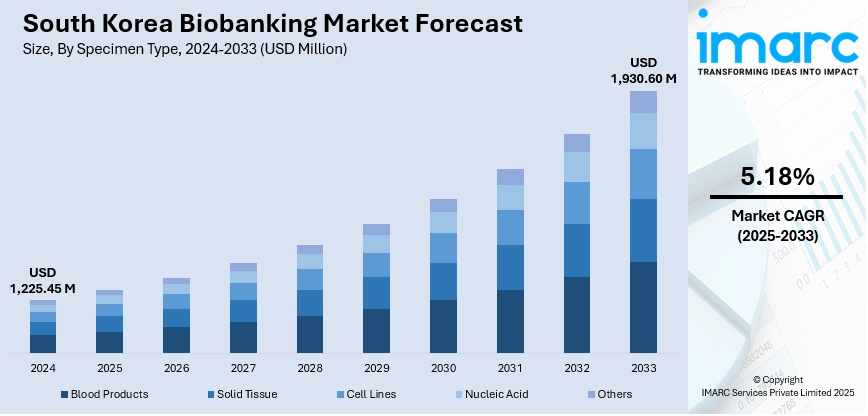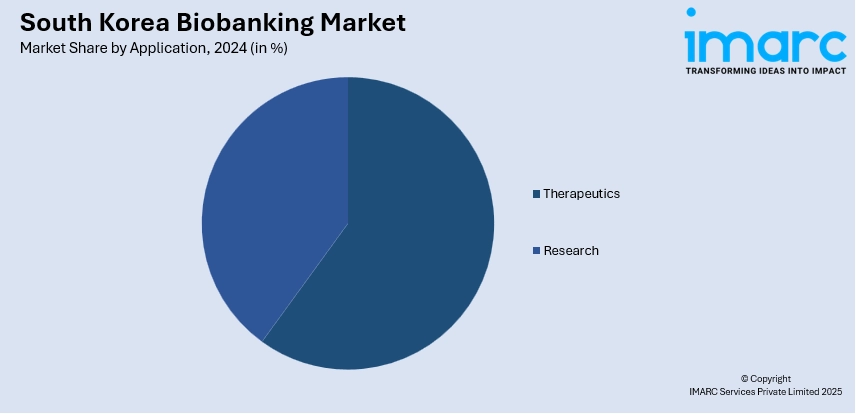
South Korea Biobanking Market Size, Share, Trends and Forecast by Specimen Type, Biobank Type, Application, End User, and Region, 2025-2033
South Korea Biobanking Market Overview:
The South Korea biobanking market size reached USD 1,225.45 Million in 2024. Looking forward, the market is projected to reach USD 1,930.60 Million by 2033, exhibiting a growth rate (CAGR) of 5.18% during 2025-2033. The market is driven by government-led development of standardized biobank networks and capacity expansion. Growing demand from precision medicine and allied life-science R&D sectors is unlocking new commercial synergies. Technological advancements in automation, informatics, and data integration are further augmenting the South Korea biobanking market share.
|
Report Attribute
|
Key Statistics
|
|---|---|
|
Base Year
|
2024
|
|
Forecast Years
|
2025-2033
|
|
Historical Years
|
2019-2024
|
| Market Size in 2024 | USD 1,225.45 Million |
| Market Forecast in 2033 | USD 1,930.60 Million |
| Market Growth Rate 2025-2033 | 5.18% |
South Korea Biobanking Market Trends:
Nationwide Research Infrastructure and Policy-driven Expansion
South Korea has invested heavily in establishing nationwide biobanking networks linked to academic hospitals, research institutes, and public health agencies. These repositories store diverse biological samples, tissue, blood, and genomic data, supporting translational research, precision medicine, and drug discovery. On 28th April 2025, the International Seabed Authority (ISA) and South Korea’s Ministry of Oceans and Fisheries signed a Letter of Cooperation during the 10th Our Ocean Conference in Busan, formalizing South Korea’s participation in the ISA Deep-Sea Biobank initiative. The initiative aims to expand global access to deep-sea biological samples and genetic data, with a focus on building research capacity, particularly for developing countries. This agreement positions South Korea as a central player in advancing marine biobanking and supports the nation’s broader strategy to lead in marine biotechnology and biodiversity conservation. The government has enacted policies mandating standardized bio-specimen collection, consent protocols, and data interoperability across institutions. Public-sector funding supports infrastructure upgrades, quality control systems, and secure IT platforms. As national projects integrate population-scale biobanks with clinical trial networks, demand for accredited sample storage and associated informatics services continues to expand. South Korea biobanking market growth is being propelled by these coordinated investments in infrastructure, professional training, and ethical governance, ensuring reliable, high-quality sample access for both local and international stakeholders.

To get more information on this market, Request Sample
Technological Integration and Data-Driven Expansion
The modern South Korean biobanking ecosystem is embracing automation, digital tracking, and integrated data platforms to enhance utility and scalability. Automated cold storage systems with remote environmental monitoring and backup power ensure sample integrity. Barcode and RFID systems synchronize physical sample movement with laboratory information management systems (LIMS), enabling audit trails and metadata capture. Advanced informatics platforms link biospecimen details with genomic, proteomic, and de-identified clinical data for AI-driven research. This integration supports cohort discovery, bioinformatics-driven stratification, and predictive modeling. Cybersecurity and privacy frameworks are embedded to comply with national data protection laws, enhancing trust among participants and stakeholders. As biobanks evolve from physical repositories to data-rich research assets, services such as sample processing, biomarker annotation, and analytics consulting are becoming profitable lines. On 9th May 2024, CHA Bio Group and CIC signed an MoU to establish a Cell Gene Biobank-based Open Innovation Center (CGB) in Pangyo 2nd Techno Valley, South Korea. The facility, spanning 66,115 square meters across 14 floors, is scheduled for completion in December 2025 and will include CDMO production lines, cGMP manufacturing, and a stem cell biobank. This initiative is set to strengthen South Korea’s biobanking infrastructure by attracting biotech ventures and integrating clinical, academic, and industrial capabilities into one global biotech hub. Cross-institutional interoperability and cloud-based data sharing further strengthen collaborations, making the platform more attractive to multinational trials. The resulting digital-first transformation positions biobanks as essential infrastructure in South Korea’s bioscience innovation landscape.
South Korea Biobanking Market Segmentation:
IMARC Group provides an analysis of the key trends in each segment of the market, along with forecasts at the country and regional levels for 2025-2033. Our report has categorized the market based on specimen type, biobank type, application, and end user.
Specimen Type Insights:
- Blood Products
- Solid Tissue
- Cell Lines
- Nucleic Acid
- Others
The report has provided a detailed breakup and analysis of the market based on the specimen type. This includes blood products, solid tissue, cell lines, nucleic acid, and others.
Biobank Type Insights:
- Population-based Biobanks
- Disease-oriented Biobanks
The report has provided a detailed breakup and analysis of the market based on the biobank type. This includes population-based biobanks and disease-oriented biobanks.
Application Insights:

- Therapeutics
- Research
The report has provided a detailed breakup and analysis of the market based on the application. This includes therapeutics and research.
End User Insights:
- Academic Institutions
- Pharma and Biotech Companies
The report has provided a detailed breakup and analysis of the market based on the end user. This includes academic institutions and pharma and biotech companies.
Regional Insights:
- Seoul Capital Area
- Yeongnam (Southeastern Region)
- Honam (Southwestern Region)
- Hoseo (Central Region)
- Others
The report has also provided a comprehensive analysis of all major regional markets. This includes Seoul Capital Area, Yeongnam (Southeastern Region), Honam (Southwestern Region), Hoseo (Central Region), and others.
Competitive Landscape:
The market research report has also provided a comprehensive analysis of the competitive landscape. Competitive analysis such as market structure, key player positioning, top winning strategies, competitive dashboard, and company evaluation quadrant has been covered in the report. Also, detailed profiles of all major companies have been provided.
South Korea Biobanking Market News:
- On 5 January 2023, Seoul Clinical Laboratories (SCL) Biobank became the first in the Asia-Pacific region to receive ISO 20387:2018 accreditation from the American Association for Laboratory Accreditation (A2LA). The certification, which followed a two-year preparation and an on-site evaluation in October 2022, confirms SCL Biobank’s operational competence and adherence to international standards for biological material handling.
- On 26 March 2025, DKSH signed an agreement to acquire Seoul-based Molecular Diagnostics Korea Inc. (MDxK), a key player in South Korea’s life sciences market, specializing in molecular diagnostics, cellular analysis, structural biology, and biobanking. MDxK, founded in 2007, employs 25 staff and generates annual net sales of approximately CHF 10 Million (USD 11 Million). This acquisition strengthens DKSH’s biobanking and scientific solutions portfolio in Korea, reinforcing its role in the country’s expanding biomedical and research infrastructure.
South Korea Biobanking Market Report Coverage:
| Report Features | Details |
|---|---|
| Base Year of the Analysis | 2024 |
| Historical Period | 2019-2024 |
| Forecast Period | 2025-2033 |
| Units | Million USD |
| Scope of the Report |
Exploration of Historical Trends and Market Outlook, Industry Catalysts and Challenges, Segment-Wise Historical and Future Market Assessment:
|
| Specimen Types Covered | Blood Products, Solid Tissue, Cell Lines, Nucleic Acid, Others |
| Biobank Types Covered | Population-based Biobanks, Disease-oriented Biobanks |
| Applications Covered | Therapeutics, Research |
| End Users Covered | Academic Institutions, Pharma and Biotech Companies |
| Regions Covered | Seoul Capital Area, Yeongnam (Southeastern Region), Honam (Southwestern Region), Hoseo (Central Region), Others |
| Customization Scope | 10% Free Customization |
| Post-Sale Analyst Support | 10-12 Weeks |
| Delivery Format | PDF and Excel through Email (We can also provide the editable version of the report in PPT/Word format on special request) |
Key Questions Answered in This Report:
- How has the South Korea biobanking market performed so far and how will it perform in the coming years?
- What is the breakup of the South Korea biobanking market on the basis of specimen type?
- What is the breakup of the South Korea biobanking market on the basis of biobank type?
- What is the breakup of the South Korea biobanking market on the basis of application?
- What is the breakup of the South Korea biobanking market on the basis of end user?
- What is the breakup of the South Korea biobanking market on the basis of region?
- What are the various stages in the value chain of the South Korea biobanking market?
- What are the key driving factors and challenges in the South Korea biobanking market?
- What is the structure of the South Korea biobanking market and who are the key players?
- What is the degree of competition in the South Korea biobanking market?
Key Benefits for Stakeholders:
- IMARC’s industry report offers a comprehensive quantitative analysis of various market segments, historical and current market trends, market forecasts, and dynamics of the South Korea biobanking market from 2019-2033.
- The research report provides the latest information on the market drivers, challenges, and opportunities in the South Korea biobanking market.
- Porter's five forces analysis assist stakeholders in assessing the impact of new entrants, competitive rivalry, supplier power, buyer power, and the threat of substitution. It helps stakeholders to analyze the level of competition within the South Korea biobanking industry and its attractiveness.
- Competitive landscape allows stakeholders to understand their competitive environment and provides an insight into the current positions of key players in the market.
Need more help?
- Speak to our experienced analysts for insights on the current market scenarios.
- Include additional segments and countries to customize the report as per your requirement.
- Gain an unparalleled competitive advantage in your domain by understanding how to utilize the report and positively impacting your operations and revenue.
- For further assistance, please connect with our analysts.
 Request Customization
Request Customization
 Speak to an Analyst
Speak to an Analyst
 Request Brochure
Request Brochure
 Inquire Before Buying
Inquire Before Buying




.webp)




.webp)












